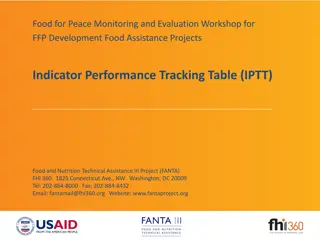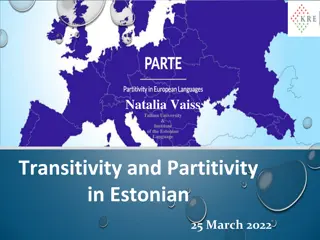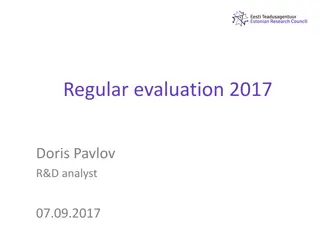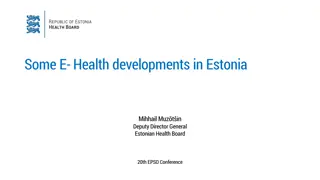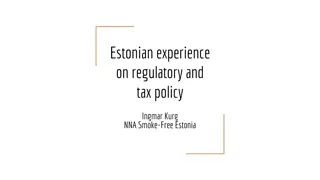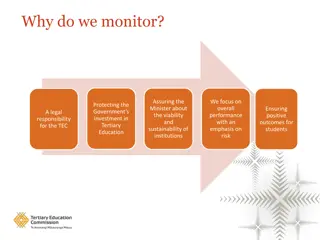Estonian Monitoring and Evaluation System Overview
Estonian Monitoring and Evaluation System involves elements like Evaluation Plan, Ex-ante and Ex-post evaluation, compulsory indicators, and regulations for data collection. It outlines the responsibilities of Managing Authorities and LAGs in planning and conducting evaluation activities. The system includes compulsory output indicators related to result and target indicators, such as new jobs created. Monitoring activities cover areas like Annual Implementing Reports, progress assessment, and contribution to Europe 2020 strategy. The cooperation projects and funding allocations are also outlined within this system.
Download Presentation

Please find below an Image/Link to download the presentation.
The content on the website is provided AS IS for your information and personal use only. It may not be sold, licensed, or shared on other websites without obtaining consent from the author. Download presentation by click this link. If you encounter any issues during the download, it is possible that the publisher has removed the file from their server.
E N D
Presentation Transcript
Estonian monitoring and evaluation system Kristine Hindriks LocalInitiativeand HumanEnvironmentBureau October28th2015
Evaluation Plan a new element underthe monitoring and evaluation framework 2014 2020 mandatory component of the RDPs. tool for Managing Authorities to plan evaluation activities during the programming period specify how monitoring and evaluation activities are going to be conducted. The responsibility of drafting the evaluation plan lies with the Managing Authority. LAG s willsubmitdatato MinistryofRuralAffairsand otheractors when itis necessary. Besides LAG-s makeself-evaluation..
Monitoring and evaluation Ex-ante evaluation Annual Implementing Report 2016-2024 (AIR) 2017 include a description of the implementation of any sub- programme included in the RDP and, if appropriate evidence is available, an assessment of the progress made towards achieving the objectives of the programme 2019 The enhanced AIR submitted in 2019 shall additionally include a further assessment of progress made towards the objectives of the programme and its contribution to the Europe 2020 strategy Ex-post evaluation
Monitoring EC compulsoryindicators Countryspecific indicators IndicatorsthatLAG-s set
Regulation that states what indicators MS should collect (target, result, output, evaluation questions) Commission Implementing Regulation (EU) No 808/2014 Context indicator Result indicator Output indicator Target indicator Evaluation questions
Result and target indicator New jobscreated.
Applicant Local Action Group Paying Agency Managing Authority Jobs created Project Application/P aymentclaim Summariz e Register Analyze/Air Type of projectpromoters (NGO, NGO-s, LAG-s, Public Bodies, SME-s Number of LAG-sselected Summariz e Analyze/AIR Summarize/Analy ze/AIR Population covered by LAG LAG submitsthe number AddsFA-s to projects(Payment claimforlinking indicators) Summariz e Analyze/AIR No of projects spread betw. FA Summariz e Analyze/AIR LAG cooperation projects inter-territorial, TNC (No of projects+euros)19.3 Preparation of co-operationprojects (euros)19.3 Uniqueno of LAGs in cooperation projects Noof LAGs selected Summariz e Summariz e Payment Claim PaymentClaim Analyze/AIR Count Analyze/AIR Count Analyze/AIR Preparation of LDS19.1. (euros) Summariz e Summariz Payment Claim Analyze/AIR Running & Animation cost (19.4) (euros) Payment Claim Analyze/AIR
Indicators according to FA-s Focus Areas 1 and 2 1A Fostering innovation, cooperation and the development of the knowledge base in rural areas 1B Strengthening the links between agriculture, food production, forestry and research and innovation, including for the purpose of improved environmental management and performance. 1C Fostering lifelong learning and vocational training in the agricultural and forestry sectors. 2A Improving the economic performance of all farms and facilitating farm restructuring and modernisation, notably with a view to increase market participation and orientation as well as agricultural diversification. 2B Facilitating entry of adequately skilled farmers into the agriculture sector and in particular generational renewal. * Number of cooperation operations (non-Article 35(1c) of Reg. (EU) N 1303/2013 operations) (number) Number of participants trained (number) Number of holdings/beneficiaries supported (number) Number of holdings/beneficiaries supported (number)
Focus Area 3 3 A Improving competitiveness of primary producers by better integrating them into the agri-food chain through quality schemes, adding value to agriculture products, promotion in local markets and short supply circuits, producer groups and organisations and inter- branch organisations. Number of holdings supported or participating in supported schemes (number) 3B Supporting farm risk prevention and management. Number of holdings supported or participating in supported schemes (number)
Focus Area 4 Forestry 4A Restoring, and preserving and enhancing biodiversity, including in Natura 2000 areas, areas facing natural or other specific constraints and High Nature Value (HNV) farming, and the state of European landscapes. Total area (forestry) (ha) forestry 4B Improving water management, including fertiliser and pesticide management. 4C Preventing soil erosion and improving soil management
Focus Area 4 Agriculture 4a Restoring, and preserving and enhancing biodiversity, including in Natura 2000 areas, areas facing natural or other specific constraints and High Nature Value (HNV) farming, and the state of European landscapes. Total area (agriculture) (ha) agriculture 4b Improving water management, including fertiliser and pesticide management. 4c Preventing soil erosion and improving soil management
Focus Area 5 5A 5B Increasing efficiency in water use by agriculture Increasing efficiency in energy use in agriculture and food processing. Total area (ha) Total investment (euros) 5C Facilitating the supply and use of renewable sources of energy, by-products, wastes, residues and other non-food raw material for purposes of the bio-economy. Total investment (euros) 5D Reducing green house gas and ammonia emissions from agriculture. Total area or number of LU (ha or nr) LU = Livestock Unit 5E Fostering carbon conservation and sequestration in agriculture and forestry. Total area (ha)
Focus Area 6 6A Facilitating diversification, creation and development of small enterprises and job creation. * 6B Fostering local development in rural areas. Population benefiting from improved services/infrastructures (number)
Country-specific monitoring indicators No of projects aimed at enterpreneurship No of cooperation projects between the enterprises Area-based specificities will be better used Finding and taking into use innovative solutions. New solutions to lose the bottle-necks on availability of services in scarcely populated rural areas To improve local governance on local level : 1. number of members per LAG; 2. number of networking projects where at least one local government participates 3. number of applicants that apply for support from LEADER measure for the first time Topics oftheproject(youthprojects, horticulture, food) Indicators setbyLAGs. Self-evaluation.
Local Action Group Paying Agency Managing Authority No of projectsthataim at enterpreneurship Check Summarize Analyze cooperation projectsbetween the enterprises Check Summarize Analyze Area-based specificities will be better used Check Summarize Analyze Finding and taking into use the innovative solutions. Check Summarize Analyze New solutions to lose the bottle-necks of availability of services in scarcely populated rural areas To improve local governance on local level : 1. number of members per LAG; 2. number of networking projects where at least one local government participates 3. number of applicants that apply for support from LEADER measure for the first time Topicsofthe project(youth projects, horticulture, localfood) Check Summarize Analyze Report - Check Summarize Analyze Count - Analyze Summarize Analyze Indicatorsset byLAGs + selfevaluation Report - Analyze
LAG monitoring indicators LAGscommunicate results of their actions to managementofLAG, local people, media, LAG itself (self-evaluation) and other interested groups. Also MA may be interested in the results. Monitoring indicators set up by LAG-s.
Some examples Budget usage(totaland bymeasure) Applications statistics Projects contribution to objectives and indicators of LDS Projects introducing new localproducts and services number of trainings, number of training hours, Number of events, increase of competence and cooperation., increased turnover of the entrepreneur, job-s maintained, better use of local resources, new products and services in the area, solved bottle-necks what concerned the services in the area
EC compulsory Jobs created Country specific (Estonia) No of projectsthataim at enterpreneurship LAG specific Budget usage(totaland bymeasure) Type ofprojectpromoters(NGO, NGO-s, LAG-s, Public Bodies, SME-s cooperation projectsbetween the enterprises Applications statistics Number of LAG-sselected Area-based specificities will be better used Projects contribution to objectives and indicators of LDS LAG animation activities and co- operation projects No of trainingsand events PopulationcoveredbyLAG Finding and taking into use the innovative solutions. New solutions to lose the bottle-necks of availability of services in scarcely populated rural areas No of projectsspreadbetw. FA, +euros LAG cooperationprojectsinter- territorial,TNC (No of projects+euros) To improve local governance on local level : 1. number of members per LAG;3. number of applicants that apply for support from LEADER measure for the first time Co-operationother thanbetween the LAGs Preparationofco-operation projects(euros) Uniqueno ofLAGs in cooperation projects 2. number of networking projects where at least one local government participates 3. number of applicants that apply for support from LEADER measure for the first time Jobs maintained Projectsintroducingnew local productsand services Noof LAGs selected Topicsofthe project(youth projects, horticulture, localfood) Self-evaluation Increaseinturnover ofenterpreneurs PreparationofLDS19.1. (euros) Improvedcultureand natureobjects Running & Animationcost(19.4) (euros)
Thankyoufor your attention! Kristine Hindriks














